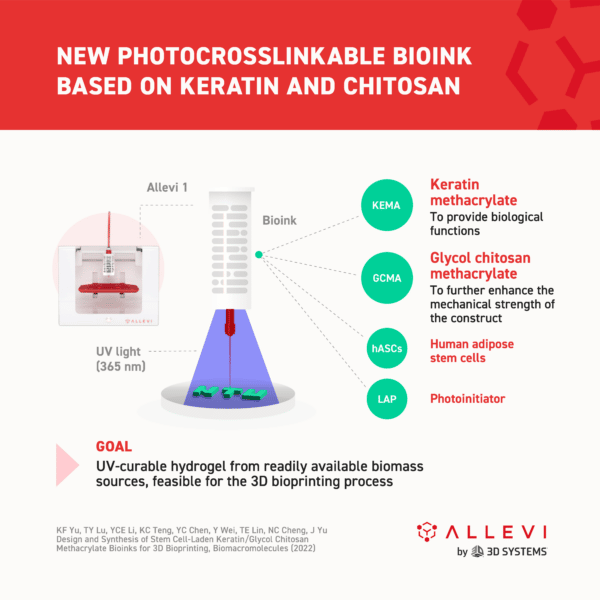
Allevi Blog
New bioink based on keratin and chitosan able to support stem cell growth
- Updated on April 17, 2023
With recent advances in 3D bioprinting technology we welcome the development of new biomaterials and bioinks, made possible by global research efforts to investigating new formulations of biomaterials and bioinks for 3D bioprinting. Yu and colleagues, a group of researchers based in Taiwan, recently published a paper presenting a potential new photocrosslinkable bioink based on keratin and chitosan that supports stem cell and spheroid loading and culture, paving ways for cell-laden biofabricated hydrogels development.
General overview
The central idea of combining these readily available biomass sources was to associate the bioactive functions of human hair keratin with the mechanical strength that chitosan can provide. For this, keratin and glycol chitosan were chemically modified to become water-soluble and photocrosslinkable, resulting in keratin methacrylate (KEMA) and glycol chitosan methacrylate (GCMA), respectively.

Main findings
Results from a series of tests and assays, including rheological and mechanical analysis, degradation profile, swelling behavior, cell viability and proliferation; the proper bioink composition and bioprinting parameters were optimized, as shown in the following table:

Research has demonstrated that both cell suspensions and cell spheroids (human adipose stem cells, hASCs) can be loaded into the newly synthesized bioink, denoted KEGC, and successfully bioprinted to build living 3D constructs.
Highlights
- New hydrogel based on readily available biomass sources, keratin and chitosan;
- Matrix option for 3D culture of cell suspensions and spheroids;
- Photocrosslinkable bioink able to support stem cell proliferation in bioprinted structures;
- Potential cell-free biomaterial option for wound regeneration in keratin-rich tissues.
Next Steps
In future investigations, the authors considered two important strategies:
- Incorporating additional active molecules to promote the differentiation of loaded stem cells in the bioink;
- Using the new hydrogel without cell loading, aiming to fill defects in keratin-rich tissues, especially the skin.
You can read the complete publication, Design and Synthesis of Stem Cell-Laden Keratin/Glycol Chitosan Methacrylate Bioinks for 3D Bioprinting, in Biomacromolecules journal. You can also read about other inspirational Allevi Authors on the Allevi by 3D Systems Blog!

